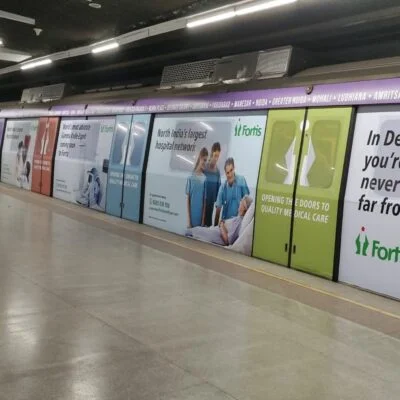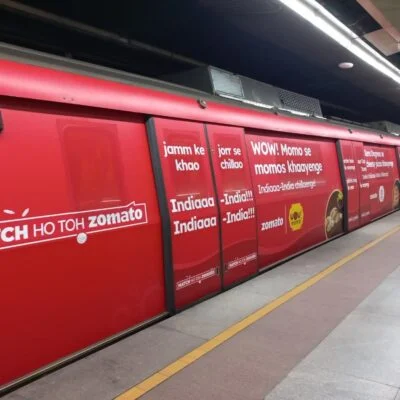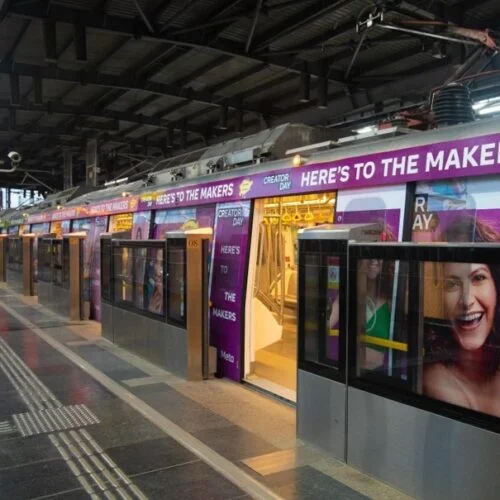
Every day, millions of people step into metro stations across cities, rushing to offices, heading back home, catching up with friends, or simply traveling through the lifelines of urban life. But while they wait for the next train or glance out of the windows during a ride, something catches their eye: a bright ad covering a pillar, a digital display beaming vibrant colors, or a train itself wrapped in a brand’s story.
Welcome to the world of Metro Branding, a powerful form of advertising that doesn’t just ride with the public; it rides into their memory.
Let’s take a journey together and explore how metro branding works, why brands love it, and what kind of impact it creates.
A Morning Routine That Connects People with Brands
Let’s imagine someone named Riya. She lives in Delhi and works in Connaught Place. Every morning, she boards the Blue Line from Dwarka. She spends around 30–45 minutes on the train, scrolling through her phone, listening to music, or looking out at the tunnel walls and station ads.
One day, she notices a metro train fully covered in vibrant visuals of a new skincare brand. At first, she only notices the colors. The next day, she sees the same brand advertised at Rajiv Chowk station, on pillars and screens. On the third day, she googles the brand while waiting for her train.
That’s the power of repetition and visibility in a captive environment.
Inside the World of Metro Branding
Metro branding is the use of advertising space within metro stations and on metro trains. It includes:
- Train Wraps (inside and outside the train)
- Platform Screen Ads
- Pillar and Wall Branding
- Escalator and Staircase Ads
- Digital Panels & LED Screens
- Station Naming Rights (where the station takes a brand’s name)
All these formats work together to capture attention in a place where people are not only present but also pausing, waiting, walking, and looking. That’s rare in today’s fast-scrolling world.
Why Are Brands Choosing Metro Branding?

Let’s break it down into real, human reasons that make metro branding attractive:
1. Unmissable Attention
In metros, ads aren’t competing with hundreds of channels or skipping buttons. They’re big, bold, and right in front of you. Whether on a train or a platform wall, the message is clear and steady.
2. High Footfall results in More Visibility
Metro stations see lakhs of passengers every day. That means brands get exposed to a huge and diverse audience, from students and office-goers to shoppers and travelers.
3. Repetition Builds Recall
When someone sees the same brand repeatedly during their daily commute, it becomes familiar. Familiarity builds trust, and trust drives purchase decisions.
4. Premium Look, Affordable Price
Metro branding gives a premium, urban impression but is often more cost-effective than large-scale hoardings or TV ads. It offers great ROI for the reach it provides.
5. Localized Targeting
Want to target young professionals? Pick a metro route near business hubs. Selling educational services? Choose stations near colleges. Metro ads can be location-specific and audience-relevant.
Different Forms of Metro Branding
Let’s take a closer look at the types of metro branding with real-world examples:
🚆 Full Train Wraps
Entire trains are wrapped with a brand’s visuals. Think of it as a moving billboard that runs across the city all day long.
Example: A food delivery app covers an entire train with its bright red branding and quirky taglines. Every person who sees it gets curious, especially when hungry.
🧱 Pillar and Wall Branding
Pillars inside stations are perfect for static but eye-level communication. Wall panels give large space for storytelling.
Example: A telecom brand promotes its 5G speed using bold typography and graphics on consecutive pillars—walking through them feels like moving through the future.
🖥️ Digital Screens
LED screens placed in high-traffic areas show dynamic ads—video, animations, and sound.
Example: A smartphone company launches a new model. The ad runs on screens at all major interchange stations—making it hard to ignore.
🏢 Station Branding
Some brands take over an entire station. From entry to exit, everything speaks the brand’s language.
Example: A real estate company wants to attract office buyers. It brands the entire station near a tech park, reaching the exact people it’s targeting.
What Kind of Brands Use Metro Advertising?
Metro branding is used by all kinds of industries:
- Education – coaching centers, universities, online courses
- FMCG – soaps, snacks, beverages
- Electronics – phones, smartwatches, TVs
- Banking & Finance – credit cards, loans, insurance
- E-commerce – shopping apps, delivery services
- Healthcare – clinics, hospitals, health tech
- Real Estate – properties near stations or city centers
Because metros connect every part of a city, brands can build both awareness and trust, two important steps before customers take action.
The Human Side of Metro Branding
Brands don’t just show products, they tell stories.
One startup shared how they got their first 10,000 app downloads just from metro ads. A skincare brand once received customer messages saying, “I see you every day on my commute, it made me try your product.”
People associate what they see repeatedly with reliability. And since metro branding surrounds them while they’re calm (not distracted by phones or work), it stays in their minds longer.
Let’s Talk Benefits – Straight and Clear
Here’s a simple list of what metro branding achieves:
- ✅ Builds brand awareness among a large urban audience
- ✅ Reaches people daily, not just once
- ✅ Creates a premium impression at a lower cost
- ✅ Allows creative storytelling using large and interactive spaces
- ✅ Enables targeted marketing by choosing specific lines or stations
- ✅ Drives offline visibility that supports online campaigns
The Future of Metro Advertising
As cities expand and metros grow deeper into suburban areas, metro branding will only become more important. Smart brands are already pairing metro ads with QR codes, app downloads, and real-time offers.
Some are using AR (Augmented Reality) experiences at stations. Others are offering discounts that pop up when a commuter taps their metro card near a branded screen.
The future of metro advertising is interactive, location-aware, and integrated with digital campaigns.
Final Thoughts: From Underground to Top of Mind
The metro isn’t just a means of transport anymore—it’s a moving marketplace, a public gallery, and a stage where brands perform for everyday people. Whether it’s a startup trying to get noticed or a legacy brand reminding people it’s still here, metro branding offers a reliable, wide-reaching, and creative solution.
In a world where digital noise often distracts people, the silent yet powerful presence of metro branding makes a mark. It’s not just about visibility—it’s about being present in the rhythm of everyday life.
So, the next time you board a metro, look around. A brand is telling you a story. And who knows? You might just become its next customer.
Expand your network with us, let’s connect on LinkedIn

